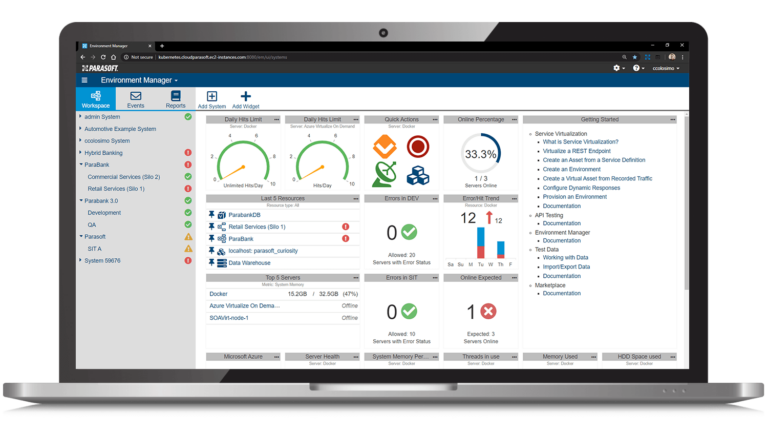Join Us on Apr 30: Unveiling Parasoft C/C++test CT for Continuous Testing & Compliance Excellence | Register Now
API Testing Tools & Solutions: Reach Quality Goals
Comprehensive, AI-enhanced API testing solutions simplify complex test case automation, elevating testing processes and empowering teams to ensure flawless API functionality, performance, and reliability.
API Testing
Streamline Testing and Ensure API Quality
Eliminate inefficient testing practices. Streamline testing with Parasoft’s AI-infused API testing solution for seamless test automation to elevate application quality and ensure APIs perform flawlessly every time.
Use AI to Accelerate and Simplify
Simplify the creation of intricate API and end-to-end test scenarios with AI. Codelessly craft intelligent, effective, and maintainable test cases.
Test Any API Interface
With support for 120+ message formats and protocols, testers can easily validate a wide range of use cases and technology stacks.
Shift Left Nonfunctional Testing
Repurpose existing functional test cases to validate nonfunctional requirements early in the SDLC with shift-left API security and performance testing.
Optimize Test Automation
Seamlessly integrate API testing into CI/CD pipelines. Optimize test execution for rapid feedback on the impact of changes and enhance quality with agility.
AI-Powered API Testing
For teams grappling with creating complex end-to-end test cases, AI-augmented API test creation eases the burden. Less technical testers can concentrate on the core business logic and easily craft intelligent, maintainable, and effective test cases for any business workflow.
How It Works
Teams can create codeless API test scenarios from recorded web UI or REST API traffic with SOAtest’s AI-infused Smart API Test Generator. The Parasoft Recorder captures API traffic from the execution of manual or automated web UI tests—regardless of the test framework.
The traffic files are imported into SOAtest where its AI engine parses the traffic file, analyzing patterns to generate and auto-configure test scenarios.
The AI analyzes the flow of data across the APIs and dynamically extracts parameters from responses applying them to downstream API requests. It automatically adds relevant assertions to generate intelligent and effective test cases.
As an option, teams can integrate SOAtest with OpenAI or Azure OpenAI providers to analyze API service definition files with user-crafted requirement prompts and use the large language model (LLM) to easily generate API scenario tests.
Read Blog: Record & Replay Testing »
Recommended Products
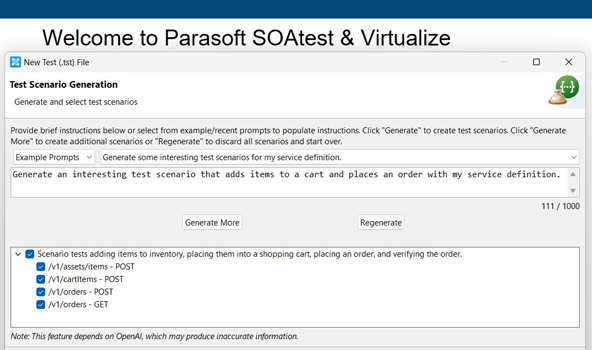
API Integration & End-to-End Testing
Simplify creating complex API integration and end-to-end test scenarios. Build and execute complex test scenarios without writing a single line of code to easily ensure seamless functionality and robust performance throughout your system.
How It Works
Parasoft SOAtest employs visual drag-and-drop tooling to create test scenarios without writing a single line of code. Using a robust menu of tools to extend test cases, teams can easily validate business logic across multiple interfaces like APIs, web UIs, databases, ESBs, and mobile devices.
Offering comprehensive support for testing over 120 different protocols and message formats, our solution establishes an integrated framework for end-to-end testing. Its flexible test suite infrastructure enables teams to easily add, organize, and execute test scenarios. Using SOAtest, testers can:
- Execute individual tests or the entire test suite with the option to attach regression controls at the test or suite level to immediately detect changed behavior.
- Readily build test flow logic, complex assertions, looping, and data driving with minimal technical experience.
- Seamlessly transition individual functional tests into scenario-based tests to facilitate the emulation of business logic or transactions and uncover bugs that may only manifest after specific sequences of events.
Recommended Products
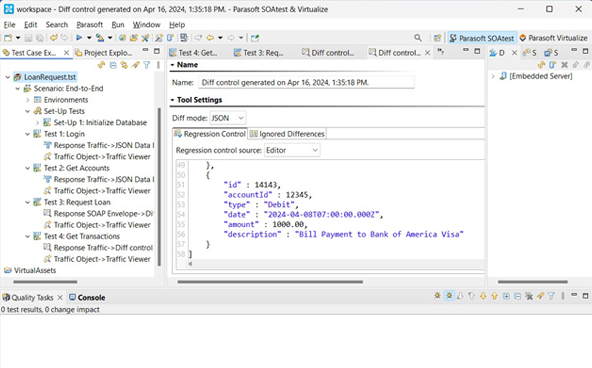


Northbridge Financial Scales API Testing to Increase Productivity & Deliver ROI
60%
Reduction in test creation time.
80%
Increase in API test coverage.
Continuous Testing and CI/CD Integration
Enable true continuous testing workflows by leveraging API testing in concert with service virtualization and environment management to create resilient, effective, and efficient automated test cases while eliminating environmental obstacles that hinder test velocity and cause testing downtime.
How It Works
Continuous testing is a process that empowers teams to build quality into software development and accelerate the delivery of high-quality customer experiences. SOAtest easily integrates into all popular CI/CD pipelines for execution, quality gates, and reporting.
Teams can optimize testing pull requests by using SOAtest’s test impact analysis to identify and run the subset of test cases required to validate the application changes. Continuously publish test results into Parasoft DTP for advanced reporting, code coverage analysis, API coverage analysis, and requirements traceability.
Leverage Virtualize, SOAtest’s sister solution, to stabilize the environment for automated testing by simulating unstable or unavailable integration and environment components. Testing teams can use Virtualize to create completely virtual test environments that can be deployed or destroyed on demand.
Read Blog: 3 Obstacles to Continuous Testing & How to Remove Them »
Recommended Products
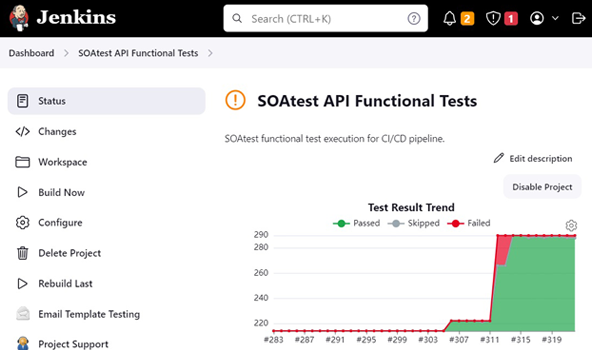
Testing Distributed Microservices
API testing for microservices ensures seamless communication between independent service components, guaranteeing reliability and scalability in distributed architectures. By rigorously performing end-to-end testing in microservices architectures, teams maintain robustness and agility, making sure microservices deliver consistent performance across diverse environments.
How It Works
Microservice testing presents a complex challenge for two primary reasons.
- Different services utilizing diverse technologies.
- The need to correlate testing outcomes across the entire environment.
Supporting 120+ protocols and message formats, SOAtest provides teams with rich support and flexibility to craft test scenarios for complex distributed systems.
It can be difficult to measure how thoroughly microservices have been tested due to their distributed nature. Our code coverage solution helps teams understand the sufficiency of their testing practice by capturing code coverage of Java and .NET microservices as they’re exercised by end-to-end test scenarios. Code coverage is reported for each individual microservice or aggregated for the application as a whole.
Validating modified microservices in the context of the entire application can be challenging and time-consuming. Parasoft’s test impact analysis identifies and executes the specific subset of end-to-end tests that must be run to validate changes in an individual microservice.
Read Blog: Microservices Testing Challenges »
Recommended Products
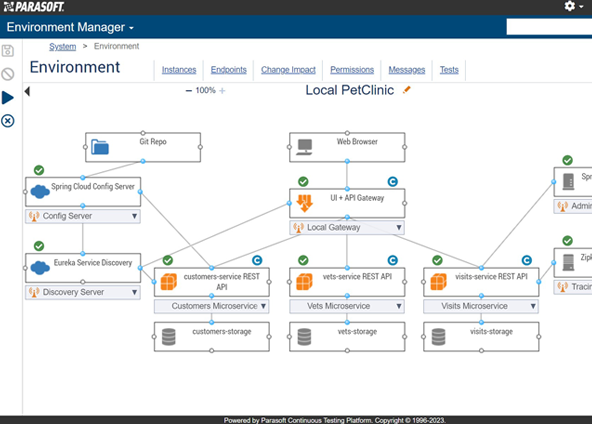
Shift Left Nonfunctional Testing
Shift nonfunctional testing left as part of the SDLC process by reusing existing API test cases for API security and performance testing.
How It Works
Use SOAtest with embedded OWASP ZAP or integrate with PortSwigger’s Burp Suite to repurpose API tests for penetration testing with ease. Teams can run security analysis for individual REST APIs or full API scenarios by selecting specific test cases and configuring them to check for vulnerabilities related to OWASP Top 10 or CWE.
Parasoft’s built-in documentation simplifies steps for testers to remediate errors reported in SOAtest. Managers and security auditors can produce detailed HTML reports that correlate violations to specific OWASP or CWE rule IDs for easy tracking.
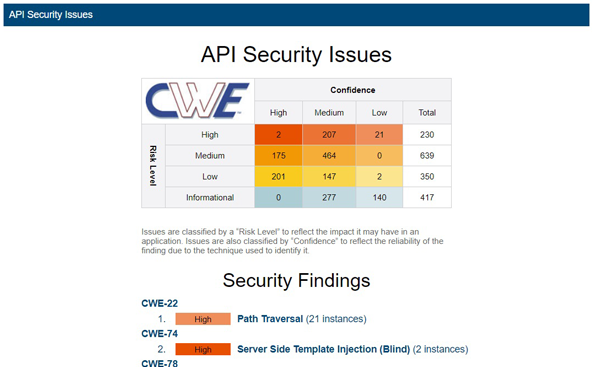
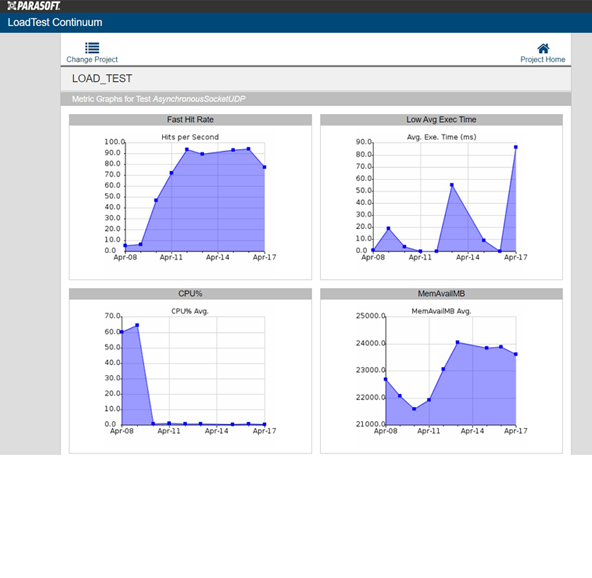
Teams can repurpose SOAtest API test cases for performance testing in a similar way.
- Select specific SOAtest API component or scenario test cases and set the load levels to satisfy performance requirements.
- Use prebuilt scenarios to monitor server response rates, detect functionality issues under load, and ensure scalability.
- Distribute virtual users across remote servers to simulate extreme loads. Integrate performance testing into CI/CD pipelines to track performance trends over time through SOAtest’s Load Test Continuum, preventing potential issues before they become costly to fix.
Read Blogs:
- How to Make API Security Testing an Automated Part of the CI Process »
- How to Optimize Performance Testing With a Shift-Left Approach »
Recommended Products
Optimize Test Execution and Maintenance When APIs Change
Test execution and test maintenance can become time-consuming as the number of test cases grows. Optimize test execution by delivering faster feedback on the impact of application changes and making API test maintenance easy and more efficient for testers.
How It Works
Teams use our solution to analyze what lines of code are executed by each test case and automatically identify which test cases are impacted when code has been modified. Testers can execute only the subset of test cases needed to validate the changes instead of executing their entire regression test suite in the CI/CD pipeline. This enables them to validate application changes faster and gain immediate feedback on the impact of changes to the application functionality.
When API contracts change, updating the existing test cases to reflect the new schemas can be tedious and time-consuming. SOAtest’s Change Advisor helps identify test cases impacted by API changes and swiftly updates them. Change Advisor analyzes the outdated service definition file against the latest version and creates a change template that testers can apply to their entire suite of tests to automatically bulk-refactor the test cases to support the new API schemas.
Read Blog: Test Smarter Not Harder: Shift Testing Left & Right With Test Impact Analysis »
Recommended Products
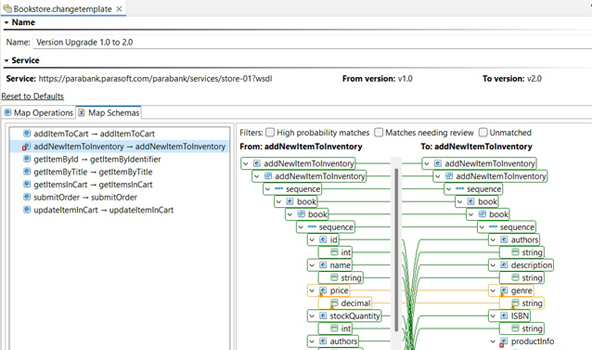
Remove API Testing Roadblocks With Service Virtualization
Overcome application testing roadblocks that hinder automated API testing velocity with service virtualization. Eliminate testing downtime and test failures caused by unstable or unavailable integration endpoints. Give testers control over the test environment.
How It Works
Unstable and unavailable test environments often hinder the ability of QA teams to meet their goals for test velocity and automation. Service virtualization enables teams to create intelligent simulations of the components they need for API integration and end-to-end testing.
Teams can shift left testing using Virtualize to do the following:
- Create simulations of APIs that haven’t been developed yet, so testing can take place in parallel with the development of dependent API services.
- Create adaptive test environments that automatically fail over to a virtual service when the live endpoint is unavailable.
- Control and modify the behavior of virtualized endpoints with ease to ensure that APIs respond appropriately and gracefully to unexpected or erroneous inputs, such as invalid parameters, missing data, out-of-range values, or other error conditions.
Recommended Products
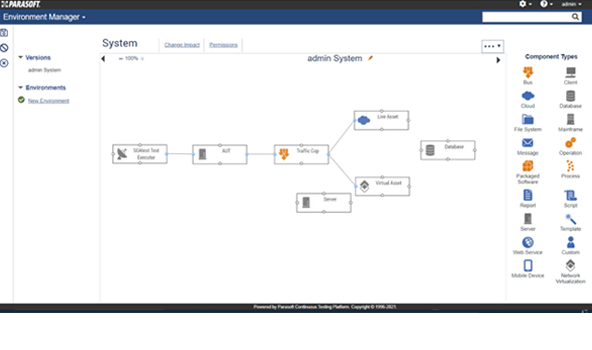


BCI Cuts Software Testing Time in Half With Service Virtualization
50%
Reduction in test flow cycles.
60%
Reduction of certification time.


Elevate your software testing with Parasoft solutions.








